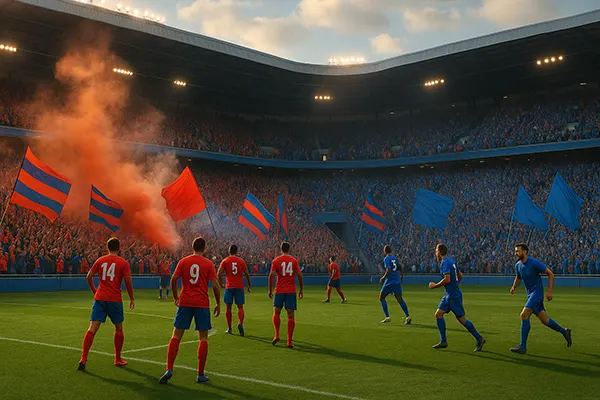
Analysing the Variability of Odds in Football Derbies: Why Classic Clashes Are Unpredictable for Bettors
Football derbies are more than just matches; they are historical, emotional, and fiercely contested confrontations that often defy logic. While form, statistics, and tactical insights help predict outcomes in regular fixtures, they tend to fall short in derbies. Bookmakers frequently adjust their odds, sometimes drastically, ahead of such events. This article delves into why these odds fluctuate and what makes these classic encounters so complex for both analysts and bettors.
Historical and Emotional Context of Derbies
Derby matches are deeply rooted in regional rivalries, cultural divisions, or long-standing histories of conflict between clubs. These factors bring a unique intensity that is not usually present in standard league fixtures. The fans’ passion, the local media’s attention, and the pride at stake create a pressure cooker atmosphere where anything can happen.
Players who typically underperform may rise to the occasion, while seasoned professionals might struggle under the weight of expectations. This emotional unpredictability contributes to fluctuating odds. Bookmakers consider not only current form but also the psychological dimension, which is harder to quantify and forecast.
Furthermore, past results in derbies often show patterns where underdogs triumph unexpectedly. Such results reshape betting markets, influencing pre-match and in-play odds. Bettors who rely solely on data might be misled in these emotionally charged matchups.
The Impact of Fan Culture and Stadium Atmosphere
Home advantage plays a magnified role in derby settings. The intense noise levels, choreographies, and even hostility can significantly affect players’ performances. Clubs like Galatasaray, Boca Juniors, or Rangers are known for their intimidating home crowds during derbies, making the environment a tactical factor on its own.
Bookmakers often adjust odds based on the stadium where the match is played, considering the historical win ratio of the host team in derby conditions. However, this element introduces a level of unpredictability that complicates modelling efforts.
In some cases, the atmosphere fuels early goals or high numbers of fouls and cards, shifting live odds dramatically. Bettors who understand this cultural layer may spot value, but the variability still poses a challenge for accurate prediction.
Market Reactions and Public Betting Behaviour
The betting market is highly reactive to public sentiment in derby situations. A surge in bets for one team—often influenced by loyalty or media hype—can skew odds, even if that team is not statistically favoured. Bookmakers respond by balancing liability rather than reflecting pure probabilities.
This shift creates distorted odds that may not align with actual chances of victory. While this opens opportunities for savvy bettors, it also increases the risks, especially when betting lines move drastically based on emotional rather than analytical grounds.
Public bets often follow popular narratives, like the return of a key player or a historic anniversary, which can inflate expectations. Odds adjust to absorb this sentiment, making it difficult for bettors to separate value from hype without deep context awareness.
Media Influence and Narrative-Driven Odds
Media coverage ahead of high-profile derbies often amplifies certain themes—revenge, redemption, or supremacy. These narratives impact how the general public perceives match outcomes, directly influencing betting volumes and odds shifts.
Bookmakers anticipate media-driven betting patterns and often pre-emptively modify odds to maintain balance. While this protects their margins, it further distances the odds from purely statistical forecasts.
Bettors who are influenced by such narratives may overlook tactical realities, recent injuries, or squad rotations. Recognising when odds reflect storytelling rather than strategy is essential in derby betting scenarios.

On-Pitch Volatility and Tactical Disruptions
Unlike standard fixtures, derbies often defy tactical norms. Managers may prioritise emotional preparation over structure, leading to unusual formations or aggressive approaches that deviate from expected tactics. This tactical flexibility disrupts models used by bookmakers to set accurate odds.
Additionally, the frequency of cards, early substitutions, or even fan interruptions in derbies adds variables that make live betting highly unstable. These real-time changes drastically shift in-play odds, complicating any form of calculated betting strategy.
Derbies also tend to involve players giving 120% effort, which can lead to fatigue, reckless fouls, or unpredictable moments late in the game. Odds that may have seemed fair pre-match can become irrelevant within minutes due to one red card or a controversial VAR decision.
Injury Risks and Player Management Challenges
In derby matches, the physicality is heightened. Hard tackles, confrontations, and emotional duels increase the likelihood of injuries or disciplinary actions. Bookmakers factor this into their live odds, especially when key players are at risk of suspension or injury during the match.
Coaches often face dilemmas in squad selection—should they risk an important player just returning from injury, knowing the game’s emotional weight? These decisions impact line-ups and, by extension, the odds offered before kick-off.
For bettors, understanding the team’s medical updates and coaching psychology is just as important as analysing the last five matches. Derby-specific risk elements affect the match course, making odds forecasting far more nuanced.



